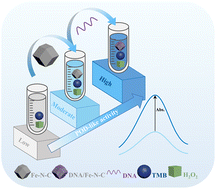Despite the current progress in optimizing and tailoring the performance of nanozymes through structural and synthetic adaptation, there is still a lack of dynamic modulation approaches to alter their catalytic activity. Here, we demonstrate that DNA can act as an auxiliary regulator via a straightforward incubation method with Fe–N–C single-atom nanozymes (SAzymes), causing a leap in the enzyme-like activity of Fe–N–C from moderate to a higher level. The DNA-assisted enhancement is attributed to the increased substrate affinity of Fe–N–C nanozymes through electrostatic attraction between the substrate and DNA. Based on the prepared DNA/Fe–N–C system, colorimetric sensors for dopamine (DA) detection were constructed. Surprisingly, the incorporation of DNA not only enabled the detection of DA in a low concentration range, but also greatly improved the sensitivity with a 436-fold decrease in detection limit. The quantitative determination of DA was achieved in two-segment linear ranges of 0.01–4 μM and 5–100 μM with an ultralow detection limit of 9.56 nM. The DNA/Fe–N–C system shows superior performance compared to the original Fe–N–C system, making it an ideal choice for nanozyme-based biosensors. This simple design approach has paved the way for enhancing nanozyme activity and is expected to serve as a general strategy for optimizing biosensor performance.
